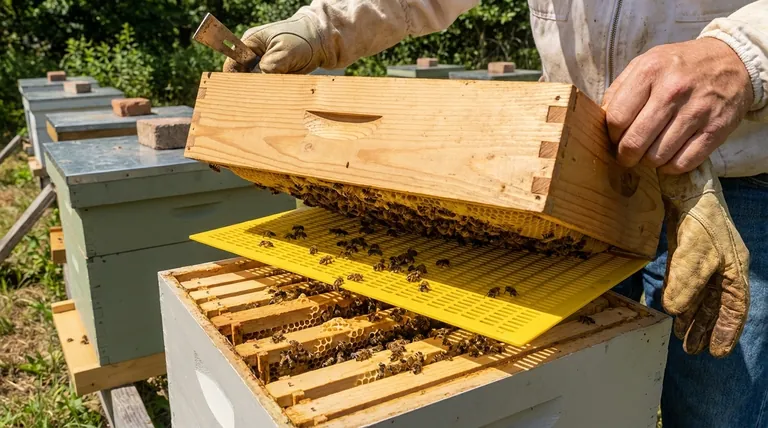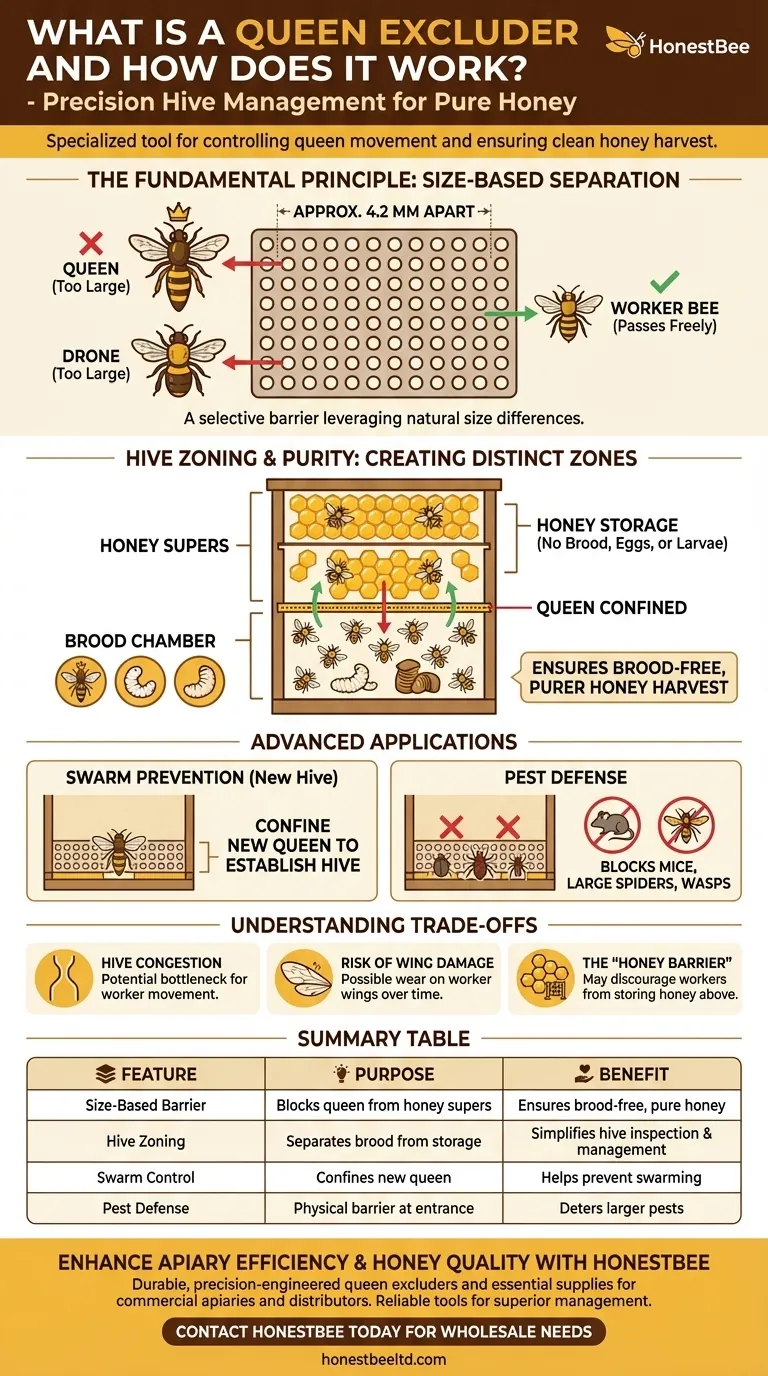A Queen Excluder is a specialized beekeeping tool designed to control where the queen bee can lay her eggs. It is a perforated screen or grid with openings large enough for smaller worker bees to pass through, but too small for the larger queen bee and drones, effectively confining her to a specific area of the hive.
The core purpose of a queen excluder is to separate the brood chamber, where the queen lays eggs and raises young, from the honey supers, where bees store surplus honey. This division simplifies hive management and ensures a purer, cleaner honey harvest.

The Fundamental Principle: Size-Based Separation
A queen excluder functions as a selective barrier, leveraging the natural size difference between bees within a colony.
How it Works
The grid is precisely engineered with slots or bars spaced approximately 4.2 millimeters apart.
This spacing allows worker bees to move freely between the brood boxes and the honey storage areas (supers) located above.
However, the queen bee, who has a larger thorax, is physically unable to squeeze through this barrier. Drones, the male bees, are also too large to pass.
The Goal: A Brood-Free Honey Super
By placing the excluder between the brood chamber and the honey supers, a beekeeper creates two distinct zones within the hive.
The queen is restricted to the lower brood boxes, where she continues her essential role of laying eggs and maintaining the colony's population.
This ensures the upper honey supers remain dedicated solely to honey storage, free from eggs, larvae, and pupae.
Why Purity Matters
Honey harvested from frames that have never contained brood is considered the highest quality.
When a queen lays eggs in a honey frame, the resulting cocoons, debris, and bee feces can darken the comb and affect the honey's flavor and purity. An excluder prevents this from happening.
Advanced Applications of the Excluder
Beyond separating honey and brood, the queen excluder serves other strategic purposes in hive management.
Preventing a New Hive from Swarming
Some beekeepers place an excluder below the bottom brood box, just above the hive's bottom board.
This traps a newly introduced queen inside, preventing her from leaving with a swarm and encouraging her to establish the hive as her permanent home.
A Defense Against Pests
When placed at the bottom of the hive, the excluder's grid also acts as a physical barrier against larger pests.
It can help block entry to threats like mice, large spiders, wasps, and even Asian giant hornets ("murder hornets").
Facilitating Specialized Production
The ability to confine the queen is also crucial for specialized beekeeping tasks, such as producing royal jelly or managing multi-queen colonies.
Understanding the Trade-offs
While highly effective, using a queen excluder is a management decision that involves balancing benefits with potential drawbacks.
Potential Hive Congestion
The excluder, by its nature, creates a bottleneck. This can slow the movement of worker bees as they travel between the brood nest and the honey supers, potentially impacting efficiency.
Risk of Physical Damage
Worker bees repeatedly squeezing through the metal or plastic grid can experience wear and tear on their delicate wings over time.
The "Honey Barrier" Debate
Some beekeepers argue that worker bees are less inclined to cross the barrier, which can lead them to store honey in the brood chamber instead of the supers. This is often referred to as creating a "honey barrier" that can sometimes limit the total honey harvest if not managed properly.
Making the Right Choice for Your Goal
The decision to use a queen excluder depends entirely on your beekeeping philosophy and objectives.
- If your primary focus is maximum honey purity and simple extraction: Using an excluder is the most direct way to ensure your honey supers remain clean and free of brood.
- If your primary focus is a more natural, less-managed hive: You may prefer to forgo an excluder, allowing the queen to move freely and managing brood patterns through other techniques.
- If your primary focus is swarm control for a new package or hive: An excluder at the entrance is a valuable, temporary tool to ensure your new colony gets established.
Ultimately, the queen excluder is a strategic tool that gives beekeepers precise control over the internal structure of their hives.
Summary Table:
| Feature | Purpose | Benefit |
|---|---|---|
| Size-Based Barrier | Blocks queen bee from honey supers | Ensures brood-free, pure honey |
| Hive Zoning | Separates brood chamber from honey storage | Simplifies hive inspection & management |
| Swarm Control | Confines new queen to establish hive | Helps prevent swarming in new colonies |
| Pest Defense | Acts as a physical barrier at the hive entrance | Deters larger pests like mice and hornets |
Ready to enhance your apiary's efficiency and honey quality?
HONESTBEE supplies durable, precision-engineered queen excluders and other essential beekeeping supplies to commercial apiaries and equipment distributors. Our wholesale-focused operations ensure you get the reliable tools you need for superior hive management and a purer harvest.
Contact HONESTBEE today to discuss your wholesale needs and optimize your beekeeping operation.
Visual Guide

Related Products
- Professional Plastic Queen Excluder for Modern Beekeeping
- Premium Wood Framed Metal Wire Queen Bee Excluder
- Wooden Queen Bee Excluder for Beekeeping
- Plastic Queen Bee Excluder for Bee Hive Wholesale
- High Performance Plastic Queen Excluder for Beekeeping and Apiary Management
People Also Ask
- How do queen excluders work in terms of spacing and bee movement? A Guide to Precision Hive Management
- What is the role of a queen excluder when adding a super? Ensure Brood-Free Honey Harvests
- What are the pros of using a queen excluder? Boost Hive Control & Honey Quality
- What are the main advantages of using a queen excluder in beekeeping? Simplify Hive Management & Harvest
- What is the primary function of a queen excluder in beekeeping? Control Hive Layout for Efficient Honey Harvesting



















